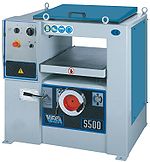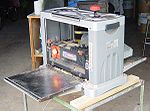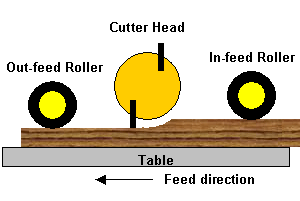
Thicknesser
Encyclopedia

Woodworking machine
A Woodworking machine is a machine that is intended to process wood. These machines are usually powered by electric motors and are used extensively in woodworking...
which is used to create boards that are of an even thickness throughout their length and flat on both surfaces.
Design

Industrial thickness planers are capable of accepting very wide boards and removing large amounts of material in a single pass. These machines are driven by powerful induction motor
Induction motor
An induction or asynchronous motor is a type of AC motor where power is supplied to the rotor by means of electromagnetic induction. These motors are widely used in industrial drives, particularly polyphase induction motors, because they are robust and have no brushes...
s and are of very heavy construction. In recent times, a range of light-weight portable thickness planers have become available which use universal motors and are much cheaper than the industrial versions.
In Europe the functions of the jointer
Jointer
A jointer is a woodworking machine used to produce a flat surface along a board's length....
and thickness planer are often combined in a single machine. In the UK this is called a planer–thicknesser or over–and–under.
Operation

In order to achieve a board that is flat and of uniform thickness along its length, it is necessary to start with a board that has at least one perfectly flat reference face. The board is fed with this reference face flat on the table and the cutter head removes an amount of material from the opposite face so that it is made parallel to the reference face. The reference face is often created by first passing the board over a jointer
Jointer
A jointer is a woodworking machine used to produce a flat surface along a board's length....
. If the lower face is not flat, the feed roller pressure pressing the board against the table will deform the board, which will then spring back as it leaves the machine, resulting in a non-flat upper surface.
One problem often encountered when using a thickness planer is snipe
Snipe (wood machining)
Snipe, in woodworking, is a noticeably deeper cut on the leading and/or trailing end of a board after having passed through a thickness planer or jointer. Its cause, in a jointer, is an out-feed table which is set too low relative to the cutter head, or in a thickness planer an unnecessarily high...
. This manifests as a deeper cut on a short section of the board at either end and is caused by incorrect feeding or misalignment of the in feed or out feed tables, or an unnecessarily high setting of the rollers recessed in the surface of the in-feed table. It can be accommodated by leaving the stock over length to allow later trimming.

